Genome-Wide Association Study Identified Novel SNPs Associated with Chlorophyll Content in Maize
Abstract
:1. Introduction
2. Materials and Methods
2.1. Plant Materials
2.2. Field Experiments
2.3. Statistical Analysis of Phenotypes
2.4. Genome-Wide Association Mapping
2.5. Prediction of Candidate Genes
2.6. Heat Map of Candidate Genes Expression
2.7. RNA Extraction and RT-qPCR
3. Results
3.1. Chlorophyll Content Diversity and Heritability at Silking
3.2. AUCCC and Heritability after Silking
3.3. Correlations of Chlorophyll Content with Other Plant Developmental Processes
3.4. Genome-Wide Association Analysis
3.5. Candidate Genes
3.6. Expression Pattern of Candidate Gene
4. Discussion
5. Conclusions
Supplementary Materials
Author Contributions
Funding
Data Availability Statement
Conflicts of Interest
References
- Raines, C.A. Increasing Photosynthetic Carbon Assimilation in C3 Plants to Improve Crop Yield: Current and Future Strategies. Plant Physiol. 2011, 155, 7. [Google Scholar] [CrossRef] [PubMed]
- Grossman, A.R.; Bhaya, D.; Apt, K.E.; Kehoe, D.M. Light-Harvesting Complexes in Oxygenic Photosynthesis: Diversity, Control, and Evolution. Annu. Rev. Genet. 1995, 29, 231–288. [Google Scholar] [CrossRef] [PubMed]
- Wang, Q.; Xie, W.; Xing, H.; Yan, J.; Meng, X.; Li, X.; Fu, X.; Xu, J.; Lian, X.; Yu, S.; et al. Genetic Architecture of Natural Variation in Rice Chlorophyll Content Revealed by a Genome-Wide Association Study. Mol. Plant 2015, 8, 946–957. [Google Scholar] [CrossRef]
- Peng, S.; Khush, G.S.; Virk, P.; Tang, Q.; Zou, Y. Progress in Ideotype Breeding to Increase Rice Yield Potential. Field Crops Res. 2008, 108, 32–38. [Google Scholar] [CrossRef]
- Teng, S.; Qian, Q.; Zeng, D.; Kunihiro, Y.; Fujimoto, K.; Huang, D.; Zhu, L. QTL Analysis of Leaf Photosynthetic Rate and Related Physiological Traits in Rice (Oryza sativa L.). Euphytica 2004, 135, 1–7. [Google Scholar] [CrossRef]
- Li, T.; Yang, H.; Lu, Y.; Dong, Q.; Liu, G.; Chen, F.; Zhou, Y. Comparative Transcriptome Analysis of Differentially Expressed Genes Related to the Physiological Changes of Yellow-Green Leaf Mutant of Maize. PeerJ 2021, 9, e10567. [Google Scholar] [CrossRef]
- Takai, T.; Kondo, M.; Yano, M.; Yamamoto, T. A Quantitative Trait Locus for Chlorophyll Content and Its Association with Leaf Photosynthesis in Rice. Rice 2010, 3, 172–180. [Google Scholar] [CrossRef]
- Wang, L.; Conteh, B.; Fang, L.; Xia, Q.; Nian, H. QTL Mapping for Soybean (Glycine max L.) Leaf Chlorophyll-Content Traits in a Genotyped RIL Population by Using RAD-Seq Based High-Density Linkage Map. BMC Genom. 2020, 21, 739. [Google Scholar] [CrossRef]
- Wang, P.; Grimm, B. Connecting Chlorophyll Metabolism with Accumulation of the Photosynthetic Apparatus. Trends Plant Sci. 2021, 26, 484–495. [Google Scholar] [CrossRef]
- Tanaka, R.; Tanaka, A. Tetrapyrrole Biosynthesis in Higher Plants. Annu. Rev. Plant Biol. 2007, 58, 321–346. [Google Scholar] [CrossRef]
- Mochizuki, N.; Tanaka, R.; Grimm, B.; Masuda, T.; Moulin, M.; Smith, A.G.; Tanaka, A.; Terry, M.J. The Cell Biology of Tetrapyrroles: A Life and Death Struggle. Trends Plant Sci. 2010, 15, 488–498. [Google Scholar] [CrossRef]
- Tanaka, R.; Tanaka, A. Chlorophyll Cycle Regulates the Construction and Destruction of the Light-Harvesting Complexes. Biochim. Et Biophys. Acta (BBA)-Bioenerg. 2011, 1807, 968–976. [Google Scholar] [CrossRef]
- Christ, B.; Hörtensteiner, S. Mechanism and Significance of Chlorophyll Breakdown. J. Plant Growth Regul. 2014, 33, 4–20. [Google Scholar] [CrossRef]
- Lin, Y.-P.; Wu, M.-C.; Charng, Y. Identification of a Chlorophyll Dephytylase Involved in Chlorophyll Turnover in Arabidopsis. Plant Cell 2016, 28, 2974–2990. [Google Scholar] [CrossRef]
- Jiang, S.; Zhang, X.; Zhang, F.; Xu, Z.; Chen, W.; Li, Y. Identification and Fine Mapping of QCTH4, a Quantitative Trait Loci Controlling the Chlorophyll Content from Tillering to Heading in Rice (Oryza sativa L.). J. Hered. 2012, 103, 720–726. [Google Scholar] [CrossRef] [PubMed]
- Suzuki, J.Y.; Bollivar, D.W.; Bauer, C.E. Genetic analysis of chlorophyll biosynthesis. Annu. Rev. Genet. 1997, 31, 61–89. [Google Scholar] [CrossRef] [PubMed]
- Zhang, G.-H.; Li, S.-Y.; Wang, L.; Ye, W.-J.; Zeng, D.-L.; Rao, Y.-C.; Peng, Y.-L.; Hu, J.; Yang, Y.-L.; Xu, J.; et al. LSCHL4 from Japonica Cultivar, Which Is Allelic to NAL1, Increases Yield of Indica Super Rice 93-11. Mol. Plant 2014, 7, 1350–1364. [Google Scholar] [CrossRef] [PubMed]
- Ye, W.; Hu, S.; Wu, L.; Ge, C.; Cui, Y.; Chen, P.; Xu, J.; Dong, G.; Guo, L.; Qian, Q. Fine Mapping a Major QTL QFCC7 L for Chlorophyll Content in Rice (Oryza sativa L.) Cv. PA64s. Plant Growth Regul. 2017, 81, 81–90. [Google Scholar] [CrossRef]
- Sakai, T.; Abe, A.; Shimizu, M.; Terauchi, R. RIL-StEp: Epistasis Analysis of Rice Recombinant Inbred Lines Reveals Candidate Interacting Genes That Control Seed Hull Color and Leaf Chlorophyll Content. G3 Genes Genomes Genet. 2021, 11, jkab130. [Google Scholar] [CrossRef] [PubMed]
- Salvi, S.; Sponza, G.; Morgante, M.; Tomes, D.; Niu, X.; Fengler, K.A.; Meeley, R.; Ananiev, E.V.; Svitashev, S.; Bruggemann, E.; et al. Conserved Noncoding Genomic Sequences Associated with a Flowering-Time Quantitative Trait Locus in Maize. Proc. Natl. Acad. Sci. USA 2007, 104, 11376–11381. [Google Scholar] [CrossRef]
- Ducrocq, S.; Giauffret, C.; Madur, D.; Combes, V.; Dumas, F.; Jouanne, S.; Coubriche, D.; Jamin, P.; Moreau, L.; Charcosset, A. Fine Mapping and Haplotype Structure Analysis of a Major Flowering Time Quantitative Trait Locus on Maize Chromosome 10. Genetics 2009, 183, 1555–1563. [Google Scholar] [CrossRef] [PubMed]
- Ravelombola, W.S.; Qin, J.; Shi, A.; Nice, L.; Bao, Y.; Lorenz, A.; Orf, J.H.; Young, N.D.; Chen, S. Genome-Wide Association Study and Genomic Selection for Soybean Chlorophyll Content Associated with Soybean Cyst Nematode Tolerance. BMC Genomics 2019, 20, 904. [Google Scholar] [CrossRef]
- Dhanapal, A.P.; Ray, J.D.; Singh, S.K.; Hoyos-Villegas, V.; Smith, J.R.; Purcell, L.C.; Fritschi, F.B. Genome-Wide Association Mapping of Soybean Chlorophyll Traits Based on Canopy Spectral Reflectance and Leaf Extracts. BMC Plant Biol. 2016, 16, 174. [Google Scholar] [CrossRef]
- Herritt, M.; Dhanapal, A.P.; Purcell, L.C.; Fritschi, F.B. Identification of Genomic Loci Associated with 21chlorophyll Fluorescence Phenotypes by Genome-Wide Association Analysis in Soybean. BMC Plant Biol. 2018, 18, 312. [Google Scholar] [CrossRef]
- Teng, S.; Wang, H.; Liang, H.; Xin, H.; Li, S.; Lang, Z. Genome-wide Association Study of Chlorophyll Content in Maize Leaves. Biotechnol. Bull. 2017, 33, 98–107. (In Chinese) [Google Scholar] [CrossRef]
- Yang, W.; Guo, Z.; Huang, C.; Duan, L.; Chen, G.; Jiang, N.; Fang, W.; Feng, H.; Xie, W.; Lian, X.; et al. Combining High-Throughput Phenotyping and Genome-Wide Association Studies to Reveal Natural Genetic Variation in Rice. Nat. Commun. 2014, 5, 5087. [Google Scholar] [CrossRef]
- Wang, X.; Wang, H.; Liu, S.; Ferjani, A.; Li, J.; Yan, J.; Yang, X.; Qin, F. Genetic Variation in ZmVPP1 Contributes to Drought Tolerance in Maize Seedlings. Nat. Genet. 2016, 48, 1233–1241. [Google Scholar] [CrossRef]
- Sun, D.; Chen, S.; Cui, Z.; Lin, J.; Liu, M.; Jin, Y.; Zhang, A.; Gao, Y.; Cao, H.; Ruan, Y. Genome-Wide Association Study Reveals the Genetic Basis of Brace Root Angle and Diameter in Maize. Front. Genet. 2022, 13, 963852. [Google Scholar] [CrossRef] [PubMed]
- Li, Y.; Liang, Y.; Liu, M.; Zhang, Q.; Wang, Z.; Fan, J.; Ruan, Y.; Zhang, A.; Dong, X.; Yue, J.; et al. Genome-Wide Association Studies Provide Insights Into the Genetic Architecture of Seed Germination Traits in Maize. Front. Plant Sci. 2022, 13, 930438. [Google Scholar] [CrossRef] [PubMed]
- Yang, J.; Carena, M.J.; Uphaus, J. Area Under the Dry Down Curve (AUDDC): A Method to Evaluate Rate of Dry Down in Maize. Crop Sci. 2010, 50, 2347–2354. [Google Scholar] [CrossRef]
- Knapp, S.J. Confidence Intervals for Heritability for Two-Factor Mating Design Single Environment Linear Models. Theoret. Appl. Genet. 1986, 72, 587–591. [Google Scholar] [CrossRef] [PubMed]
- Zhou, X.; Stephens, M. Genome-Wide Efficient Mixed-Model Analysis for Association Studies. Nat. Genet. 2012, 44, 821–824. [Google Scholar] [CrossRef]
- Cui, Z.; Luo, J.; Qi, C.; Ruan, Y.; Li, J.; Zhang, A.; Yang, X.; He, Y. Genome-Wide Association Study (GWAS) Reveals the Genetic Architecture of Four Husk Traits in Maize. BMC Genomics 2016, 17, 946. [Google Scholar] [CrossRef]
- Jiang, S.; Zhang, H.; Ni, P.; Yu, S.; Dong, H.; Zhang, A.; Cao, H.; Zhang, L.; Ruan, Y.; Cui, Z. Genome-Wide Association Study Dissects the Genetic Architecture of Maize Husk Tightness. Front. Plant Sci. 2020, 11, 861. [Google Scholar] [CrossRef]
- Nehe, A.S. Nitrogen Partitioning and Remobilization in Relation to Leaf Senescence, Grain Yield and Protein Concentration in Indian Wheat Cultivars. Field Crops Res. 2020, 251, 107778. [Google Scholar] [CrossRef] [PubMed]
- Das, A.; Guyer, L.; Hörtensteiner, S. Chlorophyll and Chlorophyll Catabolite Analysis by HPLC. In Plant Senescence; Guo, Y., Ed.; Methods in Molecular Biology; Springer: New York, NY, USA, 2018; Volume 1744, pp. 223–235. ISBN 978-1-4939-7670-6. [Google Scholar]
- Masojć, P.; Milczarski, P.; Kruszona, P. Comparative Analysis of Genetic Architectures for Nine Developmental Traits of Rye. J. Appl. Genetics 2017, 58, 297–305. [Google Scholar] [CrossRef]
- Borrego-Benjumea, A.; Carter, A.; Zhu, M.; Tucker, J.R.; Zhou, M.; Badea, A. Genome-Wide Association Study of Waterlogging Tolerance in Barley (Hordeum vulgare L.) Under Controlled Field Conditions. Front. Plant Sci. 2021, 12, 711654. [Google Scholar] [CrossRef]
- Young, G.B.; Jack, D.L.; Smith, D.W.; Saier, M.H., Jr. The Amino Acid/Auxin:Proton Symport Permease Family. Biochim. Et Biophys. Acta 1999, 1415, 306–322. [Google Scholar] [CrossRef]
- Zhang, L.; Garneau, M.G.; Majumdar, R.; Grant, J.; Tegeder, M. Improvement of Pea Biomass and Seed Productivity by Simultaneous Increase of Phloem and Embryo Loading with Amino Acids. Plant J. 2015, 81, 134–146. [Google Scholar] [CrossRef]
- Perchlik, M.; Tegeder, M. Leaf Amino Acid Supply Affects Photosynthetic and Plant Nitrogen Use Efficiency under Nitrogen Stress. Plant Physiol. 2018, 178, 174–188. [Google Scholar] [CrossRef] [PubMed]
- Chen, Y.; Wang, B.; Chen, J.; Wang, X.; Wang, R.; Peng, S.; Chen, L.; Ma, L.; Luo, J. Identification of Rubisco RbcL and RbcS in Camellia oleifera and Their Potential as Molecular Markers for Selection of High Tea Oil Cultivars. Front. Plant Sci. 2015, 6, 189. [Google Scholar] [CrossRef]
- Yadav, S.; Mishra, A.; Jha, B. Elevated CO2 Leads to Carbon Sequestration by Modulating C4 Photosynthesis Pathway Enzyme (PPDK) in Suaeda Monoica and S. Fruticosa. J. Photochem. Photobiol. B Biol. 2018, 178, 310–315. [Google Scholar] [CrossRef]
- Azoulay-Shemer, T.; Palomares, A.; Bagheri, A.; Israelsson-Nordstrom, M.; Engineer, C.B.; Bargmann, B.O.R.; Stephan, A.B.; Schroeder, J.I. Guard Cell Photosynthesis Is Critical for Stomatal Turgor Production, yet Does Not Directly Mediate CO 2- and ABA-induced Stomatal Closing. Plant J. 2015, 83, 567–581. [Google Scholar] [CrossRef] [PubMed]
- Chen, D.; Wang, S.; Cao, B.; Cao, D.; Leng, G.; Li, H.; Yin, L.; Shan, L.; Deng, X. Genotypic Variation in Growth and Physiological Response to Drought Stress and Re-Watering Reveals the Critical Role of Recovery in Drought Adaptation in Maize Seedlings. Front. Plant Sci. 2016, 6, 1241. [Google Scholar] [CrossRef]
- Singh, R.; Parihar, P.; Prasad, S.M. Sulfur and Calcium Simultaneously Regulate Photosynthetic Performance and Nitrogen Metabolism Status in As-Challenged Brassica juncea L. Seedlings. Front. Plant Sci. 2018, 9, 772. [Google Scholar] [CrossRef]
- Song, Y.; Li, C.; Zhu, Y.; Guo, P.; Wang, Q.; Zhang, L.; Wang, Z.; Di, H. Overexpression of ZmIPT2 Gene Delays Leaf Senescence and Improves Grain Yield in Maize. Front. Plant Sci. 2022, 13, 963873. [Google Scholar] [CrossRef]
- Xue, Y.; Dong, H.; Huang, H.; Li, S.; Shan, X.; Li, H.; Liu, H.; Xia, D.; Su, S.; Yuan, Y. Mutation in Mg-Protoporphyrin IX Monomethyl Ester (Oxidative) Cyclase Gene ZmCRD1 Causes Chlorophyll-Deficiency in Maize. Front. Plant Sci. 2022, 13, 912215. [Google Scholar] [CrossRef] [PubMed]
- Yamatani, H.; Ito, T.; Nishimura, K.; Yamada, T.; Sakamoto, W.; Kusaba, M. Genetic Analysis of Chlorophyll Synthesis and Degradation Regulated by balance of chlorophyll metabolism. Plant Physiol. 2022, 189, 419–432. [Google Scholar] [CrossRef] [PubMed]
- Myles, S.; Peiffer, J.; Brown, P.J.; Ersoz, E.S.; Zhang, Z.; Costich, D.E.; Buckler, E.S. Association Mapping: Critical Considerations Shift from Genotyping to Experimental Design. Plant Cell 2009, 21, 2194–2202. [Google Scholar] [CrossRef] [PubMed]
- Miculan, M.; Nelissen, H.; Hassen, M.B.; Marroni, F.; Inze, D.; Enrico, M.; Dell’Acqua, M. A Forward Genetics Approach Integrating Genome-Wide Association Study and Expression Quantitative Trait Locus Mapping to Dissect Leaf Development in Maize (Zea mays). Plant J. 2021, 107, 1056–1071. [Google Scholar] [CrossRef]
- Huang, C.; Nie, X.; Shen, C.; You, C.; Li, W.; Zhao, W.; Zhang, X.; Lin, Z. Population Structure and Genetic Basis of the Agronomic Traits of Upland Cotton in China Revealed by a Genome-Wide Association Study Using High-Density SNPs. Plant Biotechnol. J. 2017, 15, 1374–1386. [Google Scholar] [CrossRef] [PubMed]
- Ye, J.; Niu, X.; Yang, Y.; Wang, S.; Xu, Q.; Yuan, X.; Yu, H.; Wang, Y.; Wang, S.; Feng, Y.; et al. Divergent Hd1, Ghd7, and DTH7 Alleles Control Heading Date and Yield Potential of Japonica Rice in Northeast China. Front. Plant Sci. 2018, 9, 35. [Google Scholar] [CrossRef]
- Jiang, D.; Zhong, S.; McPeek, M.S. Retrospective Binary-Trait Association Test Elucidates Genetic Architecture of Crohn Disease. Am. J. Hum. Genet. 2016, 98, 243–255. [Google Scholar] [CrossRef]
- Yu, J.; Pressoir, G.; Briggs, W.H.; Vroh Bi, I.; Yamasaki, M.; Doebley, J.F.; McMullen, M.D.; Gaut, B.S.; Nielsen, D.M.; Holland, J.B.; et al. A Unified Mixed-Model Method for Association Mapping that Accounts for Multiple Levels of Relatedness. Nat. Genet. 2006, 38, 203–208. [Google Scholar] [CrossRef] [PubMed]
- Miao, C.; Yang, J.; Schnable, J.C. Optimising the Identification of Causal Variants across Varying Genetic Architectures in Crops. Plant Biotechnol. J. 2019, 17, 893–905. [Google Scholar] [CrossRef]
- Qu, Z.; Wu, Y.; Hu, D.; Li, T.; Liang, H.; Ye, F.; Xue, J.; Xu, S. Genome-Wide Association Analysis for Candidate Genes Contributing to Kernel-Related Traits in Maize. Front. Plant Sci. 2022, 13, 872292. [Google Scholar] [CrossRef] [PubMed]
- Rashid, Z.; Kaur, H.; Babu, V.; Singh, P.K.; Harlapur, S.I.; Nair, S.K. Identification and Validation of Genomic Regions Associated with Charcoal Rot Resistance in Tropical Maize by Genome-Wide Association and Linkage Mapping. Front. Plant Sci. 2021, 12, 726767. [Google Scholar] [CrossRef]
- Yi, M.; Li, A.; Zhou, L.; Chu, Q.; Song, Y.; Wu, K. The Global Burden and Attributable Risk Factor Analysis of Acute Myeloid Leukemia in 195 Countries and Territories from 1990 to 2017: Estimates Based on the Global Burden of Disease Study 2017. J. Hematol. Oncol. 2020, 13, 72. [Google Scholar] [CrossRef]
- Paraschivu, M.; Cotuna, O.; Paraschivu, M. The use of the area under the disease progress curve (AUDPC) to assess the epidemics of Septoria tritici in winter wheat. Res. J. Agric. Sci. 2013, 45, 193–201. [Google Scholar]
- Irfaq, M.; Ajab, M.; Khattak, G.S.S.; Mohammad, T.; Shah, S.J.A. Genetic Behavior of Controlling Area Under Disease Progress Curve for Stripe Rust (Puccinia striiformis f. Sp. Tritici ) in Two Wheat (Triticum aestivum) Crosses. Phytopathology 2009, 99, 1265–1272. [Google Scholar] [CrossRef]
- Shao, G.; Li, Z.; Ning, T.; Zheng, Y. Responses of Photosynthesis, Chlorophyll Fluorescence, and Grain Yield of Maize to Controlledrelease Urea and Irrigation after Anthesis. J. Plant Nutr. Soil Sci. 2013, 176, 8. [Google Scholar] [CrossRef]
- Chang, C.; Lu, J.; Zhang, H.-P.; Ma, C.-X.; Sun, G. Copy Number Variation of Cytokinin Oxidase Gene Tackx4 Associated with Grain Weight and Chlorophyll Content of Flag Leaf in Common Wheat. PLoS ONE 2015, 10, e0145970. [Google Scholar] [CrossRef]
- Ramesh, K.; Chandrasekaran, B.; Balasubramanian, T.N.; Bangarusamy, U.; Sivasamy, R.; Sankaran, N. Chlorophyll Dynamics in Rice (Oryza sativa) Before and After Flowering Based on SPAD (Chlorophyll) Meter Monitoring and Its Relation with Grain Yield. J. Agron. Crop Sci. 2002, 188, 4. [Google Scholar] [CrossRef]
- Wang, F.; Wang, G.; Li, X.; Huang, J.; Zheng, J. Heredity, Physiology and Mapping of a Chlorophyll Content Gene of Rice (Oryza sativa L.). J. Plant Physiol. 2008, 165, 7. [Google Scholar] [CrossRef] [PubMed]
- Zhao, Y.; Wang, H.; Bo, C.; Dai, W.; Zhang, X.; Cai, R.; Gu, L.; Ma, Q.; Jiang, H.; Zhu, J.; et al. Genome-Wide Association Study of Maize Plant Architecture Using F1 Populations. Plant Mol. Biol. 2019, 99, 1–15. [Google Scholar] [CrossRef] [PubMed]
- Geshnizjani, N.; Snoek, B.L.; Willems, L.A.J.; Rienstra, J.A.; Nijveen, H.; Hilhorst, H.W.M.; Ligterink, W. Detection of QTLs for Genotype × Environment Interactions in Tomato Seeds and Seedlings. Plant Cell Environ. 2020, 43, 1973–1988. [Google Scholar] [CrossRef]
- Brumme, S.; Kruft, V.; Schmitz, U.K.; Braun, H.-P. New Insights into the Co-Evolution of Cytochrome C Reductase and the Mitochondrial Processing Peptidase. J. Biol. Chem. 1998, 273, 13143–13149. [Google Scholar] [CrossRef]
- Ow, Y.-L.P.; Green, D.R.; Hao, Z.; Mak, T.W. Cytochrome c: Functions beyond Respiration. Nat. Rev. Mol. Cell Biol. 2008, 9, 532–542. [Google Scholar] [CrossRef]
- Martínez-Fábregas, J.; Díaz-Moreno, I.; González-Arzola, K.; Janocha, S.; Navarro, J.A.; Hervás, M.; Bernhardt, R.; Díaz-Quintana, A.; De la Rosa, M.Á. New Arabidopsis thaliana Cytochrome c Partners: A Look Into the Elusive Role of Cytochrome c in Programmed Cell Death in Plants. Mol. Cell. Proteom. 2013, 12, 3666–3676. [Google Scholar] [CrossRef]
- Yu, J.; Zhang, Y.; Di, C.; Zhang, Q.; Zhang, K.; Wang, C.; You, Q.; Yan, H.; Dai, S.Y.; Yuan, J.S.; et al. JAZ7 Negatively Regulates Dark-Induced Leaf Senescence in Arabidopsis. J. Exp. Bot. 2016, 67, 751–762. [Google Scholar] [CrossRef]
- Wang, H.-L.; Zhang, Y.; Wang, T.; Yang, Q.; Yang, Y.; Li, Z.; Li, B.; Wen, X.; Li, W.; Yin, W.; et al. An Alternative Splicing Variant of PtRD26 Delays Leaf Senescence by Regulating Multiple NAC Transcription Factors in Populus. Plant Cell 2021, 33, 1594–1614. [Google Scholar] [CrossRef]
- Cernac, A.; Benning, C. WRINKLED1 Encodes an AP2/EREB Domain Protein Involved in the Control of Storage Compound Biosynthesis in Arabidopsis: WRI1 Controls Seed Oil Biosynthesis. Plant J. 2004, 40, 575–585. [Google Scholar] [CrossRef] [PubMed]
- Dietz, K.-J.; Vogel, M.O.; Viehhauser, A. AP2/EREBP Transcription Factors Are Part of Gene Regulatory Networks and Integrate Metabolic, Hormonal and Environmental Signals in Stress Acclimation and Retrograde Signalling. Protoplasma 2010, 245, 3–14. [Google Scholar] [CrossRef] [PubMed]
- Zhou, Y.; Xia, H.; Li, X.-J.; Hu, R.; Chen, Y.; Li, X.-B. Overexpression of a Cotton Gene That Encodes a Putative Transcription Factor of AP2/EREBP Family in Arabidopsis Affects Growth and Development of Transgenic Plants. PLoS ONE 2013, 8, e78635. [Google Scholar] [CrossRef]
- Liu, C.; Zhang, T. Expansion and Stress Responses of the AP2/EREBP Superfamily in Cotton. BMC Genomics 2017, 18, 118. [Google Scholar] [CrossRef] [PubMed]
- Thornburg, T.E.; Liu, J.; Li, Q.; Xue, H.; Wang, G.; Li, L.; Fontana, J.E.; Davis, K.E.; Liu, W.; Zhang, B.; et al. Potassium Deficiency Significantly Affected Plant Growth and Development as Well as MicroRNA-Mediated Mechanism in Wheat (Triticum aestivum L.). Front. Plant Sci. 2020, 11, 1219. [Google Scholar] [CrossRef]
- Sun, J.; Yang, L.; Yang, X.; Wei, J.; Li, L.; Guo, E.; Kong, Y. Using Spectral Reflectance to Estimate the Leaf Chlorophyll Content of Maize Inoculated with Arbuscular Mycorrhizal Fungi Under Water Stress. Front. Plant Sci. 2021, 12, 646173. [Google Scholar] [CrossRef]
- Zhang, Y.; Li, Y.; Han, B.; Liu, A.; Xu, W. Integrated Lipidomic and Transcriptomic Analysis Reveals Triacylglycerol Accumulation in Castor Bean Seedlings under Heat Stress. Ind. Crops Prod. 2022, 180, 114702. [Google Scholar] [CrossRef]
- Eklund, D.M.; Edqvist, J. Localization of Nonspecific Lipid Transfer Proteins Correlate with Programmed Cell Death Responses during Endosperm Degradation in Euphorbia lagascae Seedlings. Plant Physiol. 2003, 132, 1249–1259. [Google Scholar] [CrossRef]
- Wu, J.; Sun, Y.; Zhao, Y.; Zhang, J.; Luo, L.; Li, M.; Wang, J.; Yu, H.; Liu, G.; Yang, L.; et al. Deficient Plastidic Fatty Acid Synthesis Triggers Cell Death by Modulating Mitochondrial Reactive Oxygen Species. Cell Res. 2015, 25, 621–633. [Google Scholar] [CrossRef]
- Wagoner, J.A.; Sun, T.; Lin, L.; Hanson, M.R. Cytidine Deaminase Motifs within the DYW Domain of Two Pentatricopeptide Repeat-Containing Proteins Are Required for Site-Specific Chloroplast RNA Editing. J. Biol. Chem. 2015, 290, 2957–2968. [Google Scholar] [CrossRef] [PubMed]
- Zhang, J.; Xiao, J.; Li, Y.; Su, B.; Xu, H.; Shan, X.; Song, C.; Xie, J.; Li, R. PDM3, a Pentatricopeptide Repeat-Containing Protein, Affects Chloroplast Development. J. Exp. Bot. 2017, 68, 5615–5627. [Google Scholar] [CrossRef] [PubMed]

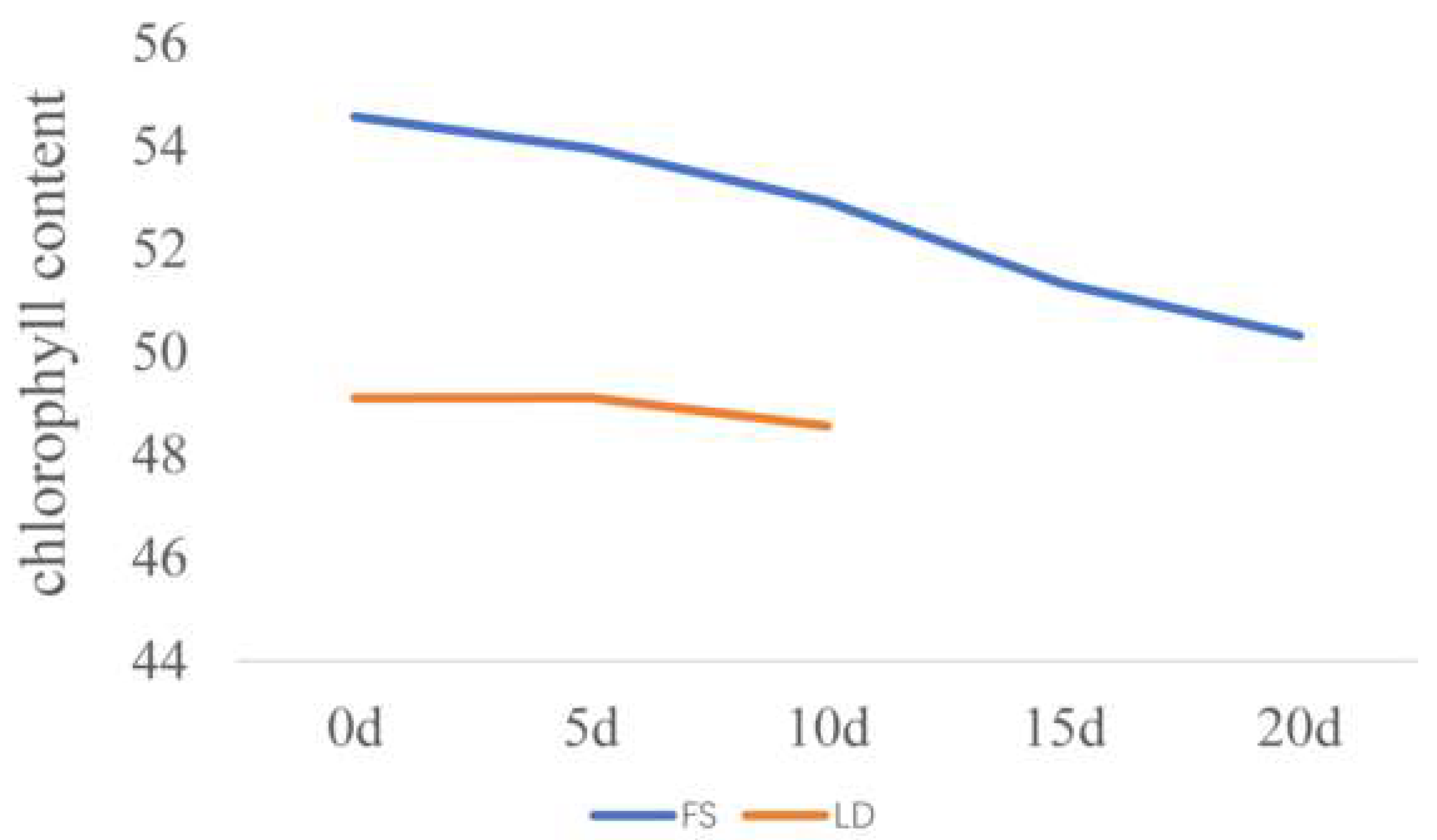

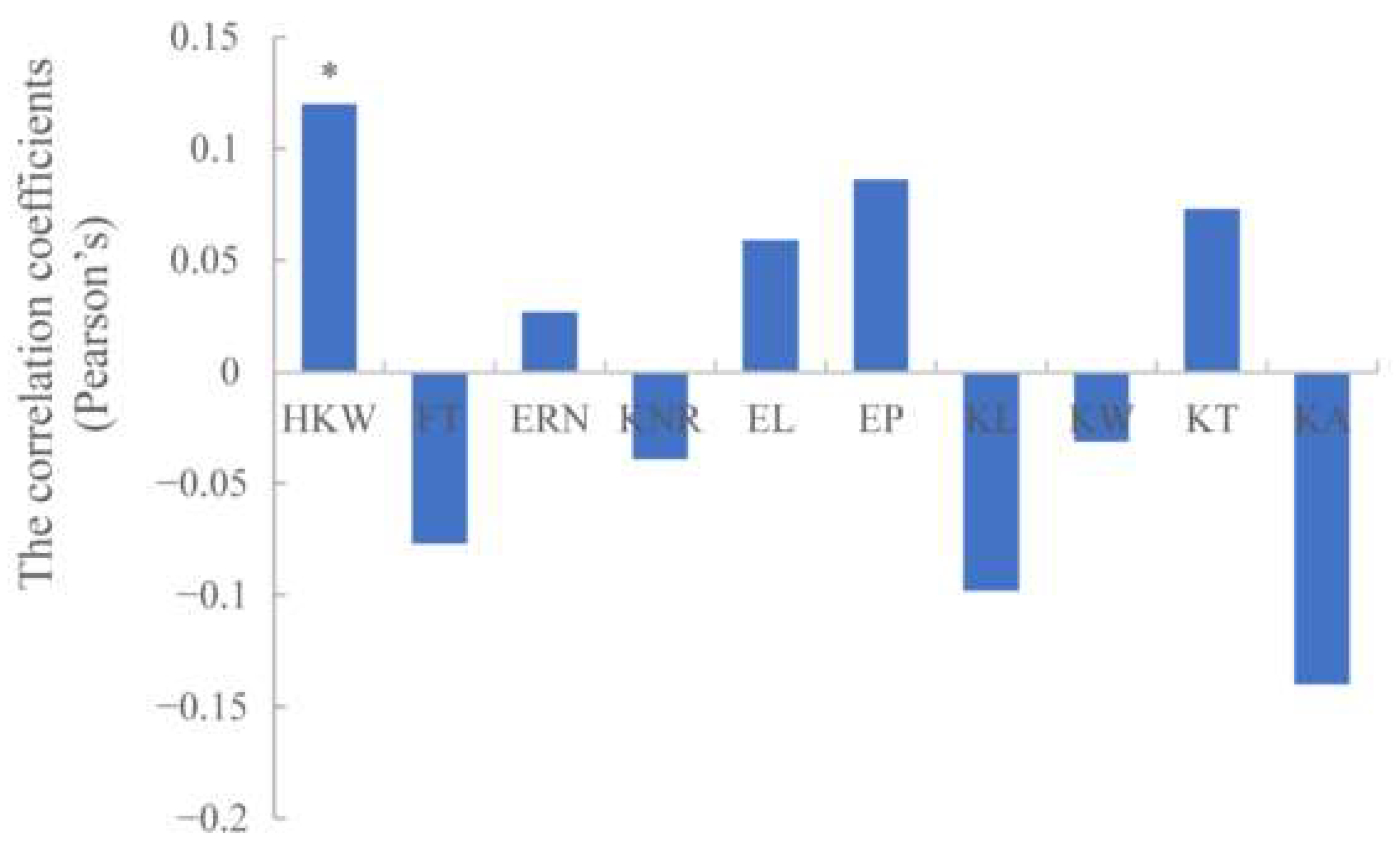
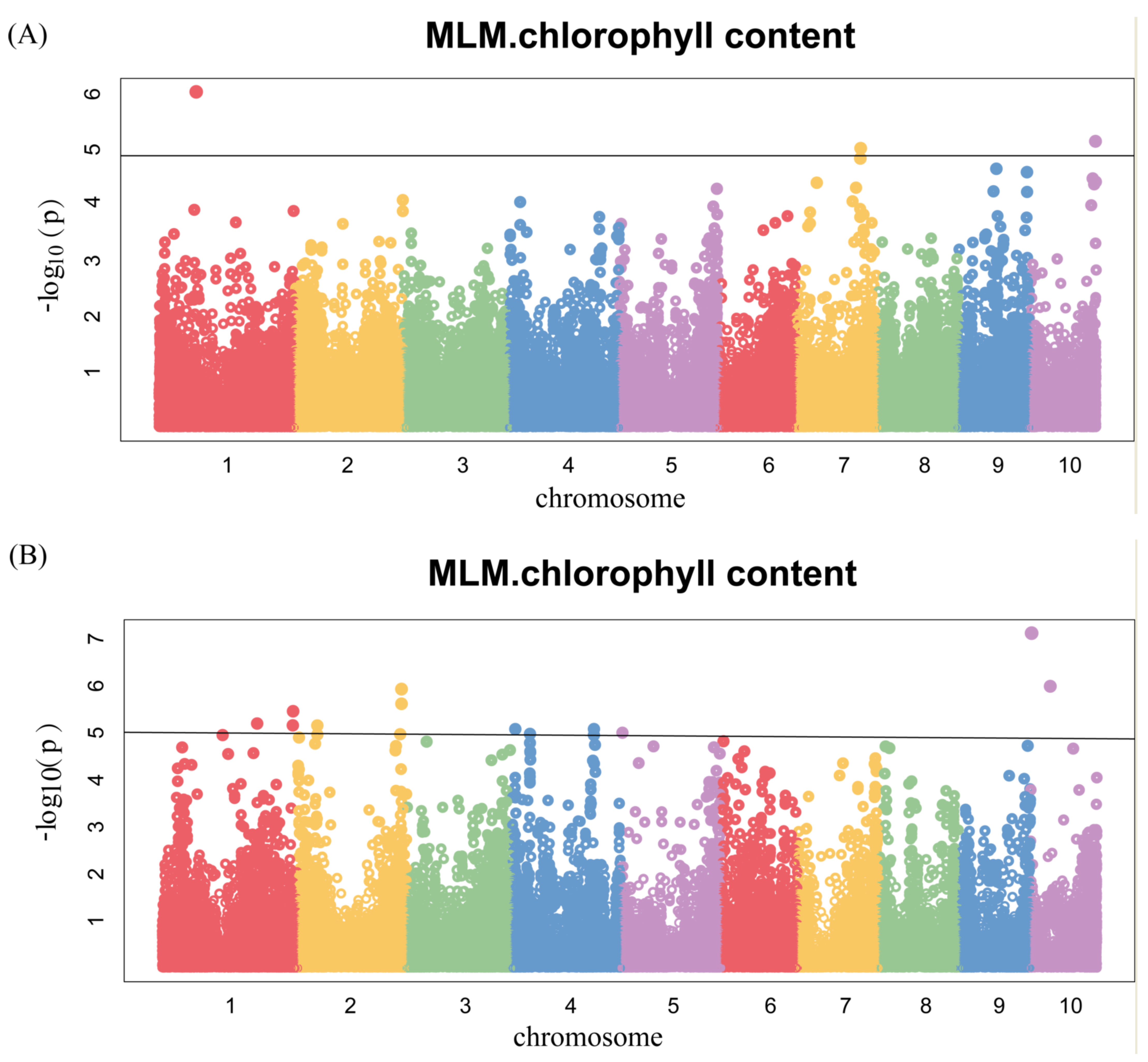

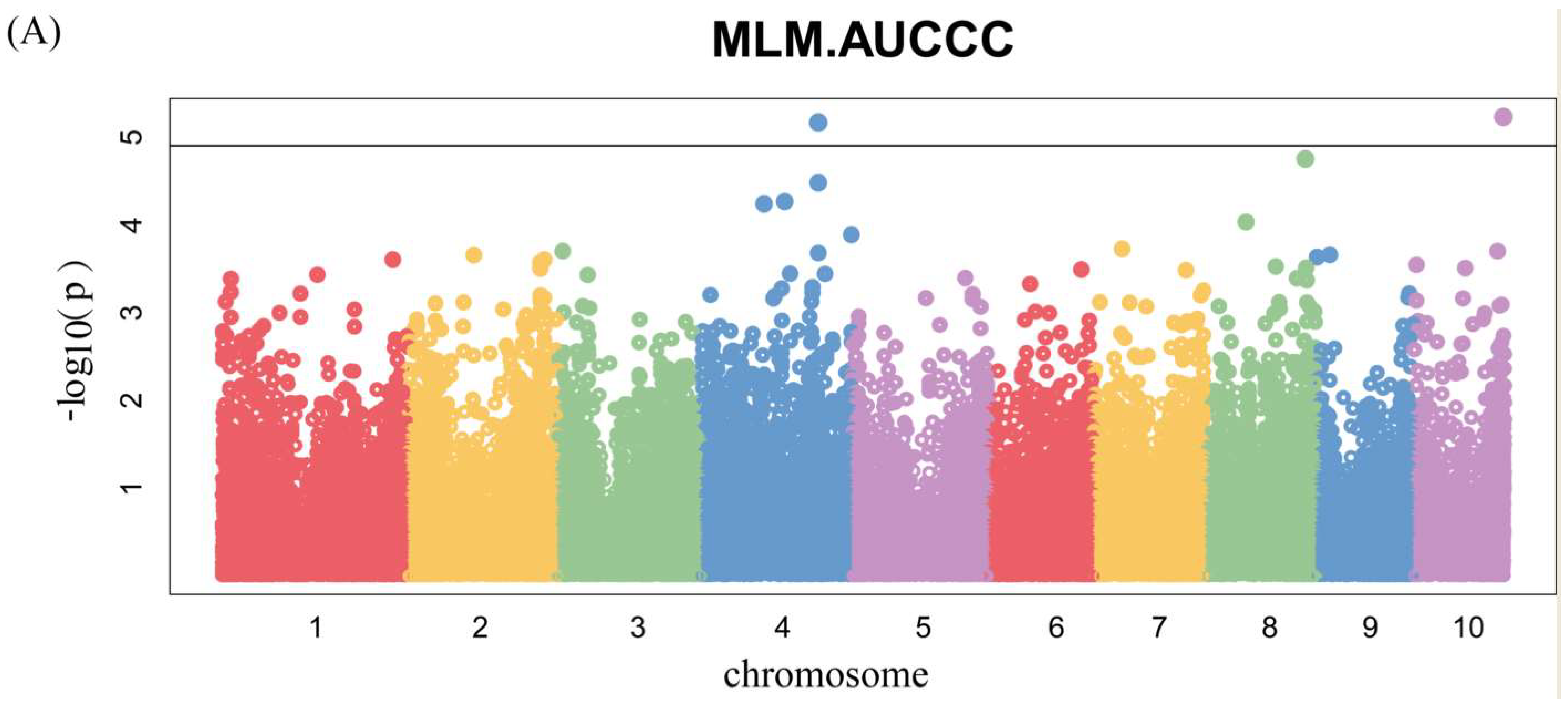
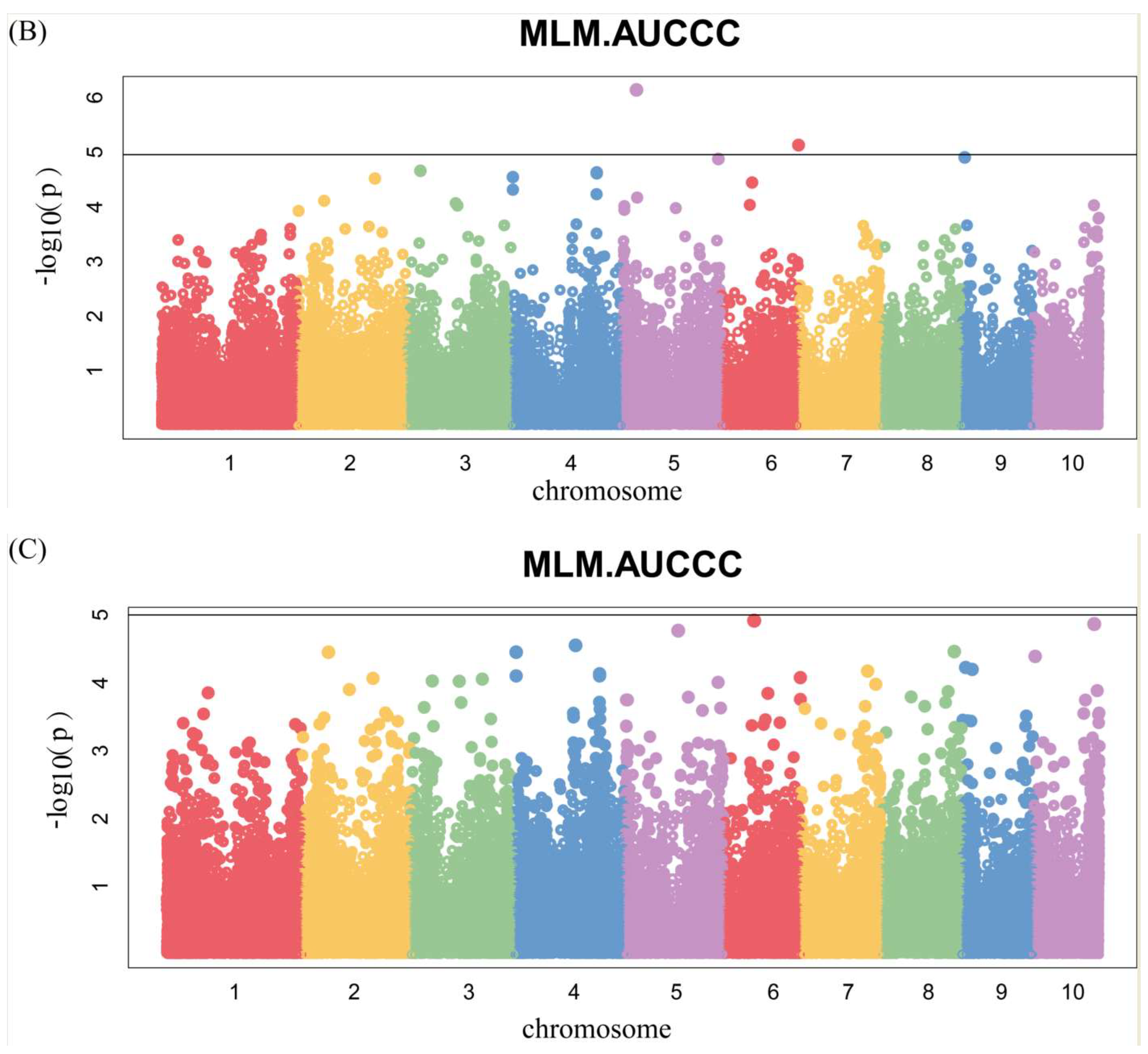
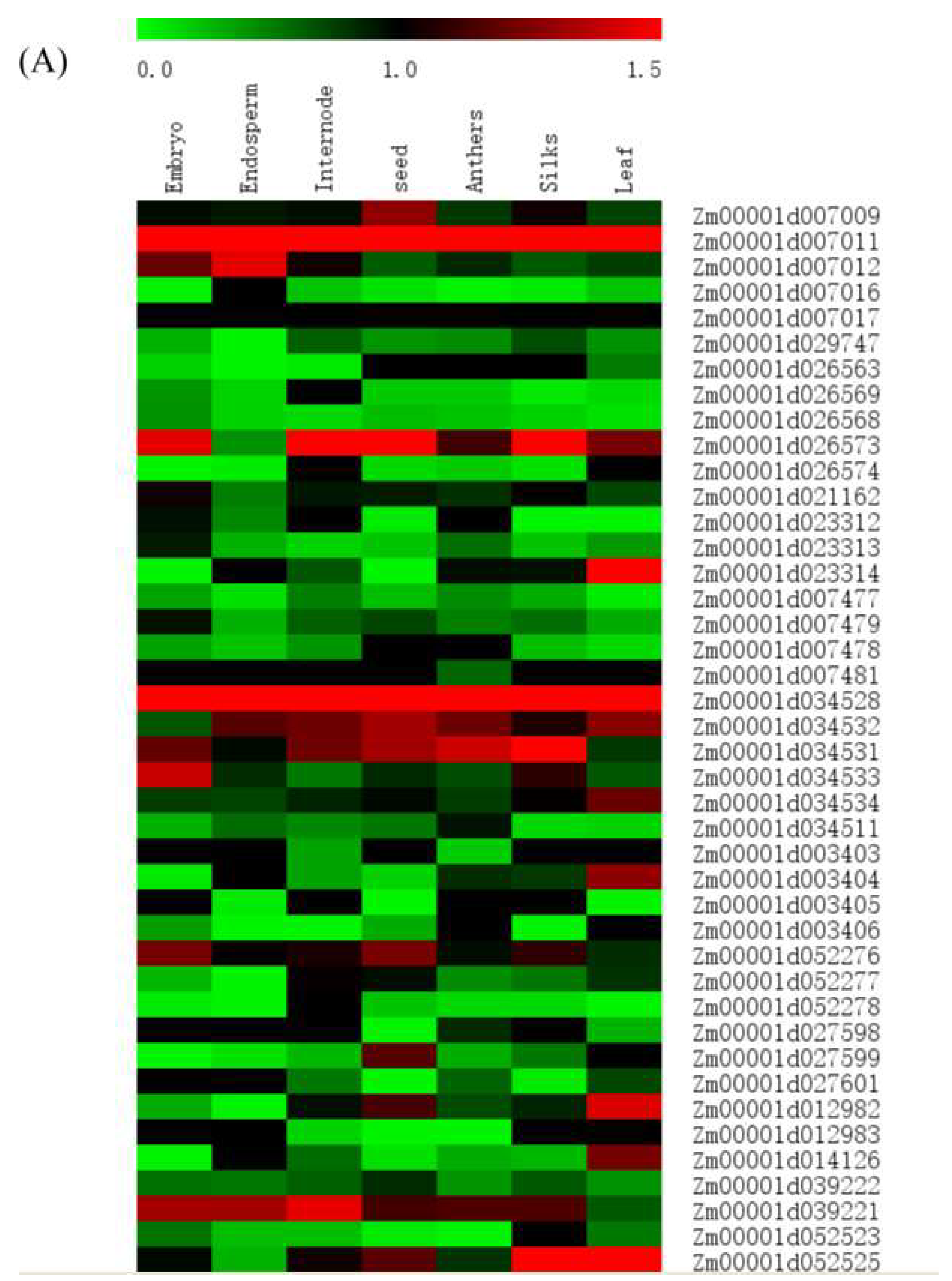

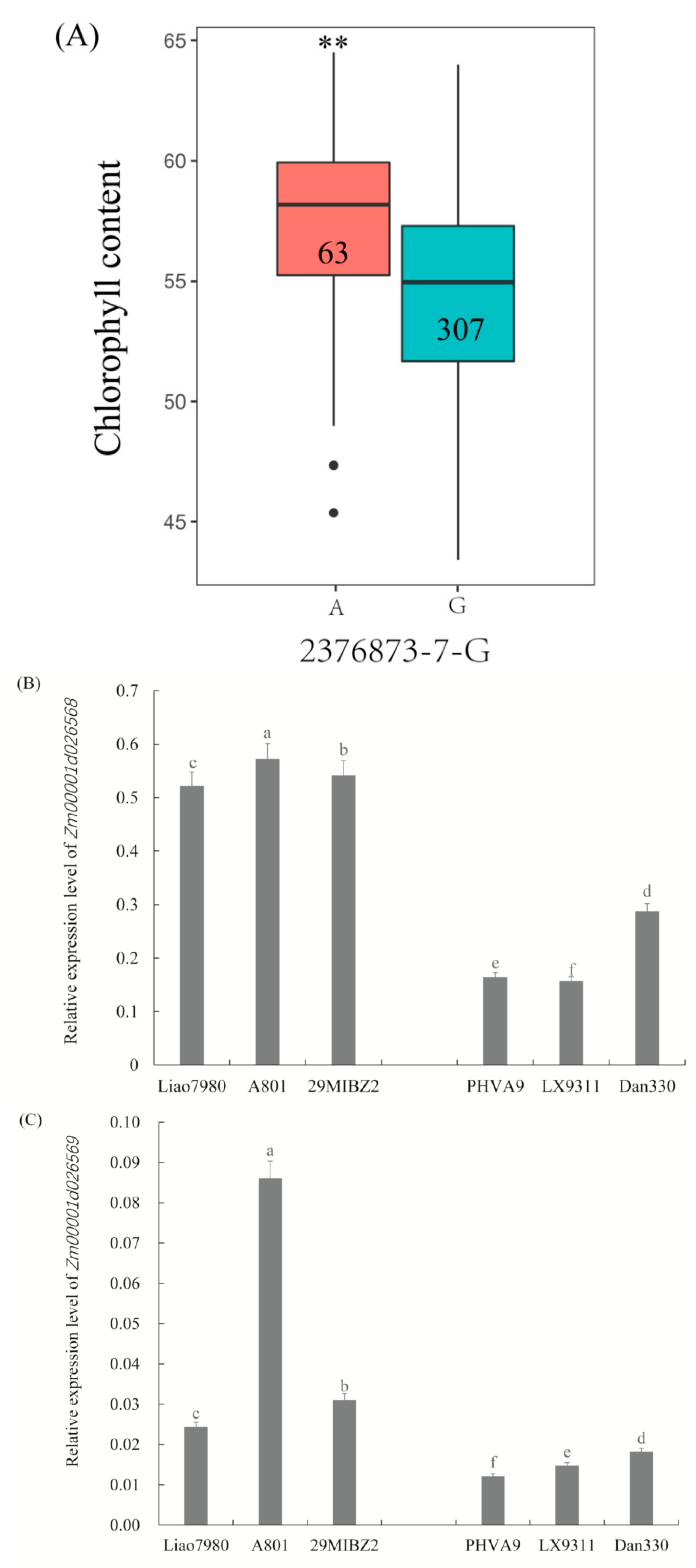
| Source of Variation a | Mean Square | Significance b | H2 c | |
|---|---|---|---|---|
| chlorophyll content | Environment (E) | 10058.20165 | <0.01 ** | 0.67 |
| Genotype (G) | 190.14580 | <0.01 ** | ||
| G × E | 155.13709 | 0.4034 | ||
| AUCCC | Environment (E) | 149.3227937 | <0.01 ** | 0.66 |
| Genotype (G) | 1.1585265 | <0.01 ** | ||
| G × E | 0.405332 | 0.0987 |
| Trait | SNP | Chr | Position (bp) | p Value | Gene | Gene Interval (bp) | Annotation | Pathway |
|---|---|---|---|---|---|---|---|---|
| 17BLUP chlorophyll content | Marker.247949 | 2 | 2.20 × 108 | 9.10 × 10−6 | Zm00001d007009 | Chr2:220125041-220148355 | DNAJ heat shock N-terminal domain-containing protein | Chloroplast targeting, photosystem II repair |
| Zm00001d007011 | Chr2:220152033-220155206 | ATP synthase | Energy metabolism | |||||
| Zm00001d007012 | Chr2:220170458-220175539 | CHLOROPLAST RNA-BINDING PROTEIN | Chloroplast morphogenesis | |||||
| Zm00001d007016 | Chr2:220204271-220219191 | disease resistance protein RGA2 | Disease-resistant | |||||
| Zm00001d007017 | Chr2:220217348-220221222 | thioredoxin-like protein AAED1 chloroplastic | Electronic circulation and daylighting | |||||
| 17FS chlorophyll content | 2376873-7-G | 10 | 1.48 × 108 | 7.08 × 10−6 | Zm00001d026563 | Chr10:148153479-148157015 | AP2/EREBP transcription factor 40 | Plant growth and development |
| Zm00001d026569 | Chr10:148185247-148190302 | chloroplastic palmitoyl-acyl carrier protein thioesterase | De novo synthesis of fatty acids | |||||
| Zm00001d026568 | Chr10:148184610-148195615 | pentatricopeptide repeat-containing protein | Chloroplast development | |||||
| Zm00001d026573 | Chr10:148201459-148207853 | 5-methylthioribose kinase | Methylthioadenosine (MTA) cycle | |||||
| Zm00001d026574 | Chr10:148208912-148217798 | UDP-D-galacturonate | Homogalacturonan biosynthesis | |||||
| 17LD chlorophyll content | Marker.190636 | 2 | 43,281,907 | 6.97 × 10−6 | Zm00001d003403 | Chr2:43279990-43285413 | aaap10—amino acid/auxin permease10 | Amino acid transportation |
| Zm00001d003404 | Chr2:43284025.43288746 | transmembrane protein | Transmembrane | |||||
| Zm00001d003405 | Chr2:43285551-43289511 | protease inhibitor/seed storage/LTP family protein | Signal transduction | |||||
| Zm00001d003406 | Chr2:43298285-43304459 | actin binding protein | Plant growth and development | |||||
| Marker.346487 | 4 | 8,724,268 | 8.32 × 10−6 | Zm00001d027598 | Chr1:8676135-8681000 | cct101—CO CO-LIKE TIMING OF CAB1 protein domain101) | Transcription factors, floral completion | |
| Zm00001d027599 | Chr1:8699800-8704356 | alkane hydroxylase MAH1 | Cuticular wax biosynthesis | |||||
| Zm00001d027601 | Chr1:8772748-8777355 | behenate ω-hydroxylase | Suberin monomers biosynthesis | |||||
| 2504165-22-G | 5 | 2,775,822 | 9.93 × 10−6 | Zm00001d012982 | Chr5:2770681-2776100 | NAD(P)-binding domain containing protein | Energy metabolism | |
| 17LD AUCCC | Marker.571424 | 6 | 1.73 × 108 | 7.40 × 10−6 | Zm00001d039222 | Chr6:173160699-173165510 | cct40—CO CO-LIKE TIMING OF CAB1 protein domain40) | Transcription factors, floral completion |
| Zm00001d039221 | Chr6:173158717-173163744 | nucleoside diphosphate kinase 4 | Signal transduction | |||||
| 17FS AUCCC | 2376873-7-G | 10 | 1.48 × 108 | 5.82 × 10−6 | Zm00001d026563 | Chr10:148153479-148157015 | ereb40—AP2-EREBP-transcription factor 40 | Plant growth and development |
| Zm00001d026568 | Chr10:148184610-148195615 | pentatricopeptide repeat-containing protein, mitochondrial-like | Chloroplast development | |||||
| Zm00001d026569 | Chr10:148185247-148190302 | palmitoyl-acyl carrier protein thioesterase, chloroplastic | De novo synthesis of fatty acids | |||||
| Zm00001d026573 | Chr10:148201459-148207853 | 5-methylthioribose kinase | Methylthioadenosine (MTA) cycle | |||||
| Zm00001d026574 | Chr10:148208912-148217798 | UDP-D-galacturonate | Homogalacturonan biosynthesis |
Disclaimer/Publisher’s Note: The statements, opinions and data contained in all publications are solely those of the individual author(s) and contributor(s) and not of MDPI and/or the editor(s). MDPI and/or the editor(s) disclaim responsibility for any injury to people or property resulting from any ideas, methods, instructions or products referred to in the content. |
© 2023 by the authors. Licensee MDPI, Basel, Switzerland. This article is an open access article distributed under the terms and conditions of the Creative Commons Attribution (CC BY) license (https://creativecommons.org/licenses/by/4.0/).
Share and Cite
Jin, Y.; Li, D.; Liu, M.; Cui, Z.; Sun, D.; Li, C.; Zhang, A.; Cao, H.; Ruan, Y. Genome-Wide Association Study Identified Novel SNPs Associated with Chlorophyll Content in Maize. Genes 2023, 14, 1010. https://doi.org/10.3390/genes14051010
Jin Y, Li D, Liu M, Cui Z, Sun D, Li C, Zhang A, Cao H, Ruan Y. Genome-Wide Association Study Identified Novel SNPs Associated with Chlorophyll Content in Maize. Genes. 2023; 14(5):1010. https://doi.org/10.3390/genes14051010
Chicago/Turabian StyleJin, Yueting, Dan Li, Meiling Liu, Zhenhai Cui, Daqiu Sun, Cong Li, Ao Zhang, Huiying Cao, and Yanye Ruan. 2023. "Genome-Wide Association Study Identified Novel SNPs Associated with Chlorophyll Content in Maize" Genes 14, no. 5: 1010. https://doi.org/10.3390/genes14051010





